|
Dear Colleague:
Provisioning and inventory systems used to be backstage,
batch-oriented, single-purpose systems designed to made life
easier for "swivel-chair" engineers who made manual network
changes.
Now, however, as telecoms face the daunting tasks of
configuring smartphones and triple play video services,
provisioning and inventory systems are increasing "going
live" and becoming far more real-time, integrated,
multi-layered, and mechanized.
Here are some product trends and achievements that are
changing the OSS fulfillment landscape:
- Inventory systems are moving closer to the
network. Subex Azure's solution, for instance, is
breaking new ground for
AT&T's triple play, offering daily service discovery
and tight integration between inventory and provisioning
to support "on-the-fly" customer self-service ordering.
- Wireless service bundles have become so complex that
synchronizing billing and provisioning requires great
technical dexterity. Comptel is addressing the problem
with a new central product catalog that
interfaces with the CRM and configures network elements
and content servers.
- Traditionally, as new networks are deployed,
telecoms migrate their OSS systems to a new platform.
Now, rules-based provisioning from Fastwire
abstracts generic design rules and allows
Optus in Australia
to preserve its OSS investments and enable targeted
network deployment to specific regions and customer
bases.
- Automated over-the-air handset provisioning
will soon enable 2.5G handsets to sport email, calendar,
and other Blackberry-like features. Here, Synchronica is
lightening the provisioning load for operators by
providing server side tools to allow real-time
interaction with phone users.
- Traditional network management systems lack a
precise view of IP devices underneath making it risky to
automate network grooming. Now Canadian operator
Telus is using an
Intelliden system to detect potential IPTV network
outages and launch mechanized and policy-based
reconfiguration that reduces the high expense and
errors of manual provisioning.
- When it comes to large-scale VoIP provisioning, the
OSS/BSS and network systems are often not fast enough to
deliver the instantaneous response needed to support a
self-care portal. To gain real-time performance,
Comcast uses a
Jacobs Rimell solution that maintains a persistent,
virtual provisioning layer that normalizes,
federates, and synchronizes operational data.
On the strength of these innovations, TRI pegs the market for provisioning and inventory
software market at $1.3 billion in 2006 and forecasts it to
grow to $1.8 billion in 2011.
Telecoms' urgent need for these efficiency and service-enabling
solutions presents great opportunities for companies and
internal IT shops who supply fulfillment software and related
services.
And that's precisely why your team needs to get a copy of
TRI's latest research study on the fulfillment
market: Telecom
Provisioning, Network Inventory, Activation & Service Management
Solutions.
This Report analyzes this complex market and shows how you and your
company can capitalize on the niches and avoid dangerous
forays into markets that are either too competitive or too
specialized to attract enough paying customers.
Whether you're a carrier executive aiming to improve your
OSS infrastructure or a vendor delivering inventory,
provisioning, or service management and related solutions, the Report will help you discover:
- What are the most important market
priorities?. . .
- Which success strategies
of other operators can you adopt at your own
telecom organization?
- Which vendors have industry
market share and are leading in specific niches?. . .
- What's the impact of large players such as
Oracle and Amdocs
entering the market?
- Which OSS players should you partner
with?. . .
- What emerging trends
can
your company capitalize on?. . .
Please scan the executive summary and full table of
contents below. You'll see why this report delivers the
tactical and strategic information you need to fully
understand where telecom provisioning and inventory systems
are headed.
To access this market intelligence today, contact
Wyatt Greenwalt at
TRI's
offices at 301-652-8350.
Sincerely,

Dan Baker
Research Director, TRI OSS/BSS KnowledgeBase
P.S. This Report is one research module in TRI's on-going OSS/BSS
KnowledgeBase covering the breadth of telecom
software and OSS innovations on a yearly basis.
Table
of Contents
Telecom
Provisioning,
Inventory, Activation &
Service Management Solutions
A. Executive Summary (2 pages)
B. Network Inventory (10 pages)
1. The Emergence of Capacity Inventory
2. Capacity Inventory -- Its Chief Characteristics
3. The Elegance of Inventory Federation
4. Bringing Just-in-Time Inventory to Play
5. Why itís Hard to Maintain Inventory in Modern Networks
6. How Poor Inventory Affects Provisioning
7. Provisioning Benefits of Accurate Inventory
8. Service Assurance Benefits of Accurate Inventory
9. Inventory's Value Beyond Provisioning
10. Telcordiaís Approach to Federation
C. IP Service Provisioning (5 pages)
1. Marrying IP Connectivity and IP Service Delivery
2. Cable Operator Comcast's Consolidated IP Platform
3. The Importance of Subscriber Management Systems
4. Why Enterprises are Looking to IP-VPNs
5. Provisioning Software for IP-VPNs
6. The Rise of Ethernet Competition to IP-VPNs
7. Metro Ethernet Yipes Rises Again as a National Ethernet
Provider
D. Rules Based Provisioning (4 pages)
1. Do New Network Deployments Require a New OSS?
2. How Rules-Based Differs from the Current Provisioning
Model
3. Consulting the Provisioning Design Playbook
4. Fastwire's Rules-Driven Design Abstraction
5. A Way to Strategically Insert New Network Technology
E. Terminal Provisioning (4 pages)
1. Market Drivers: Handsets, Protocols, Services, &
Automation
2. How Terminals are Provisioned
3. Complications in Terminal Provisioning
4. Two-Way Communication with the Handset
5. Device Management: Enabling a Mobile Email Explosion?
F. Access Network Provisioning (4 pages)
1. That Precious Telecom Asset -- Facilities in the Last
Mile
2. Why Access Network Automation is Vital to Next Generation
Services
3. The Benefits of Outside Plant Integration
4. Access Network Provisioning Benefits to Customer Care
G. Product Catalog (2 pages)
1. The Disconnect Between BSS and Provisioning Layers
2. Manufacturing Style Production
3. Market Demand for Product Catalogs
H. Carrier Interconnect Ordering (2
pages)
1. Interconnect: From Legal Battles to Business as Usual
2. Cable Providers Boost the Intercarrier Ordering Game
I. Network Planning, Design & Engineering
(2 pages)
1. The Coming Merger of Engineering and Provisioning Worlds
2. The Information & Culture Gap
3. The Role of Network Planning Software
J. Service Design and Order Management (11
pages)
1. Maintaining Eight Million Customers with a Manual
Ordering System
2. The Customer & Network-Facing Sides of Telecom Service
Orders
3. Network Orders and Billing Bundles
4. Why Cross-Industry Ordering Solutions Donít Fit Telecom
5. The Economics of Order Process Change
6. The Requirement for Advanced Order Management
7. Features of an Advanced Order Management System:
Expeditor
8. The Complexity of Network Order Management
9. Setting Priorities for Inventory/Provisioning Systems
10. Steps in the Provisioning a Service for an Enterprise
Customer
11. Not Being Captive to Genius Designers
12. Product Management Design vs. Implemented Design
12. Handling Manual Work Instructions
13. Designs Using the Provisioning "Lego" Model
14. Automation - Real-Time Quotes & Customer Responsiveness
15. Designing in Network Diversity
16. Limitations to Design Automation
17. How Business Policy Affects Fulfillment
17. Human Intervention in Provisioning
K. Provisioning History & Migration To NGN
(3 pages)
1. Provisioning Simplicity in the Circuit Voice World
2. Next Gen Networks: Multi-Vendor and Multi-Technology
Complexity
3. Uniting the Data and Network Layers
4. The Dynamic Nature of NGN Networks
L. Provisioning Mechanization &
Flow-Through (2 pages)
1. The Human Engineer in the OSS Loop
2. The Challenge of Flow Through Provisioning
M. Transport Network Provisioning (3
pages)
1. The History of the Merchant Provisioning/Inventory Market
2. The Purpose of a Transport Provisioning System
3. The Many OSS Systems Transport Provisioning Touches
4. Adding Business Rules during Service Creation
N. Service Management Systems (4 pages)
1. From Vertical Silos to a Horizontal Service Management
System
2. Service Management Components
3. Managing Component Dependencies
4. The Product Conception to Deployment Advantage
5. Instantiating the Service for the Customer
6. Service Management Initiative at Orange/France Telecom
O. Service Activation in Wireline
Networks (2 pages)
1. Basic Function of Wireline Network Activation
2. Shortening the Provisioning-to-Activation Process
P. Telecom Network Discovery (6 pages)
1. Telecom Network Discovery: Elements, Topology, Services
2. Why Telecom Discovery is Bound to Become More Important
3. The Value of Real-Time Inventory Reconciliation
4. Major Steps in the Telecom Discovery Process
5. The Auto Discovery & Upload Process
7. Discovery Across Telecom Equipment Clouds
8. Associating Network Assets with Services
9. Recovering Stranded Assets
10. Asset Reclamation -- Reconciling with Billing
11. Layer 1 Service Discovery
Q. Control Planes & Intelligent Agent
Discovery (2 pages)
1. Distributed vs. Centralized Network Management
2. How the Control Plane Discovers Topology
3. Example of Agent Peer-to-Peer Communication
R. Service Delivery Platform (2 pages)
1. SDP -- Defining a New Product Category 73
2. Telcordia's Multi-Purpose SDP Platform 74
3. SDPs & Large Telecoms 74
S. Content Management Systems (2 pages)
1. Definition and Functions
2. Content Acquisition & Bundling
3. Why Content Management Gives Carriers Better Control
T. IP Multimedia Subsystem (IMS) & the
OSS (2 pages)
1. Managing Multimedia Applications in an IP Services World
2. Instant Messenger IMS Implementation at SK Telecom
3. IMS Analysis and Alternative Solutions
U. Market Threats & Recommendations (3
Pages)
X. Market Segmentation & Forecast Analysis
(6 pages)
1. How TRI Develops its Market Segmentations
2. Market Growth Forecast
3. OEM vs. Service Provider
4. Distribution Channels
5. Geographic Region
6. Service Provider Type
7. Service Provider Size
8. Type of Provisioning & Inventory Solution
9. Networks/Devices Provisioned & Inventoried
Y. Case Studies (30 pages)
1. SingTel Optus: Rules-Based Provisioning & Inventory
2. Verizon's FIOS Provisioning & National Desktop
3. Verizon Wireless Content Management System
4. CenturyTelís Access-to-Transport DSL Provisioning System
4. Telecom Italia Sparkleís International Network Inventory
5. XO Communications Inventory & Provisioning System
Z. Provisioning & Inventory Definitions (4
pages)
Case
Studies

SingTel Optus Rules Based Provisioning & Inventory System
SingTel Optus is Australiaís second largest telecom offering
a full suite of residential, wholesale and business services
including Internet access, VPNs, Ethernet, mobile, voice and
data. Since 2001, the company has been owned by SingTel, one
of the largest communications service providers in Asia
Pacific. The company serves 4 million Australian homes
and revenues reached $6.7 billion in its 2007 fiscal year.
To win market share from the incumbent operator, Telstra,
Optus had to significantly reduce the time required to turn
up services for new and existing customers. The company
decided to achieve this goal by fully automating its
provisioning process for its highest volume business
communications services.
Automating the design and assign process has resulted in a
deduction in service design times from hours to minutes for
complex services. It further enables for example ďbatchingĒ
of similar orders. The net effect is that the complete
service order provisioning cycle has been reduced by up to
two days per service.

Verizon's FIOS Provisioning & National Desktop
The complexity of Verizon's current provisioning environment
has made it extremely difficult to support COTS
implementation.
The case explains the complexity of Verizon's OSS/BSS
environment and why the decision was made to develop
Verizon's next generation broadband FiOS environment
in-house.
FiOS is a true triple play service because voice data and
video are converged on a single pipe.
The study explains how the system's unique architecture that
separates the complexities of fiber from the transactions
pushed into Verizon's regular provisioning flow.
Another complication was to create a national system for
provisioning to handle workflows across the company's East
and West systems.'

CenturyTel's Access-to-Transport Provisioning System
CenturyTel
wanted a fully integrated and automated solution to speed up
the process and eliminate the errors that occur in assigning
DSLAM-to-ISP facilities manually.
The case shows how CenturyTel migrated its entire access
and network provisioning into an integrated
access-to-transport provisioning, managing over 4,000
devices and 200,000 customers. (9 pages including 4
figures)

Telecom Italia Sparkle's International
Network Inventory
Providing complex, customized services for
many of its large customers was proving costly for Telecom
Italia's international network unit, Sparkle.
The case shows how Telecom Italia Sparkle
delivered a single point of management for all services
configuration and activation across its retail and wholesale
operations, integrated with CRM, and unified legacy systems.
(6 pages including 2 figures)

Verizon Wireless Content Management
System
Verizon
Wireless recognized the revenue opportunities
afforded by IP content, but was looking for a solution that
would manage the many aspects of content management from a
central platform.
The case reveals the goals, challenges, and
benefit Verizon realized from implementing an electronic
content supply chain with revenue sharing controls, partner
settlements, subscriber profiling, and user device tracking.
(4 pages including 1 figure)

XO Communications Inventory &
Provisioning System
Consolidation was a pressing need for XO
Communications because -- from an ordering
perspective -- XO had two separate networks, its own and the
Allegiance network it had recently acquired.
The case study shows combined two inventory systems and
built integrations to mechanize provisioning operations to
lower costs, reduce the order-to-bill interval, and
eliminate manual provisioning errors.
Vendor
Profiles
Over twenty-two vendors have established themselves on the
telecommunications provisioning and inventory scene in recent years.
In this section, TRI analyzes each of the leading companies
in 2 to 5 page profiles delivering:
- Historical expertise and background
- Specific areas of strength and weaknesses
- Significant customers and partnerships
- Key products
- Differentiators that make the company standout
- The company's provisioning/inventory revenue for 2006
These vendor profiles and technical specs are a great
time-saver: they deliver the kind of information you'd
otherwise have to spend weeks tracking down. A list of
vendors profiled follows:
Market
Segments & Forecasts
TRI sizes and forecasts the worldwide market for
provisioning, inventory and service management software and
services. Our forecast model is based on several parameters:
TRI's historical
tracking of the OSS market; TRIís forecast of Next Generation Network
(NGN) services growth; discussions with carrier experts; and interviews with software and
consulting vendors.
The report provides 2006 base revenue and 2007 to 2011
forecast data for the global market in the following segments:
1. OEM vs. Service Provider Market
2. Distribution Channel
- Direct vs. Indirect Channels
3. Geographic Region
- North America, EMEA, Asia Pacific, Latin
America
4. Service Provider Type
- Wireline Voice, Broadband, Wireless,
Cable, Reseller, Other
5. Service Provider Size
- Tier 1, 2, and 3
6. Functional Category of Provisioning/Inventory
- Transport Network Provisioning
- Access Network Provisioning
- Network Inventory
- Service Activation & Discovery
- Order Management
- Content Management
- Service Management & IP Services Provisioning
- Intercarrier Order Gateway
- Wireless Provisioning
- Other
7. Type of Network/Device Provisioned or Inventoried
- Radio Access Networks|
- ATM/Frame Networks
- Broadband Networks
- Transmission Networks
- Fixed or Mobile Core TDM & Mobile HLR
- IP & Corporate Networks
- Service Delivery & IN Machinery
- Mobile, CPE & Home Terminals
- Other Networks/Devices
About
TRIís
B/OSS Market Research Reports
TRIís B/OSS market research studies are designed to help telecoms and OSS/BSS vendors track
market innovation in the sector.
Each of our reports delivers a fully
organized body of knowledge and analysis across three
interfaces:
- Complete Microsoft
Word text of Report and Vendor Profiles.
Forecasts are delivered in MS Excel;
- A Compiled HTML file
for your desktop
PC that allows searching the text and
visuals of our analysis modules, case studies, and
vendor profiles; and,
- A Software Application
(written in Microsoft Visual Foxpro) with market
segmentation and forecast data that you use to view
customized data tables, graphs, vendor comparisons, and
print documents. Note: all data and forecast
tables are also provided in Microsoft Excel and
comma delimited files can be created too.
Below are some sample screens:
Compare
vendor market strength in grids. . .
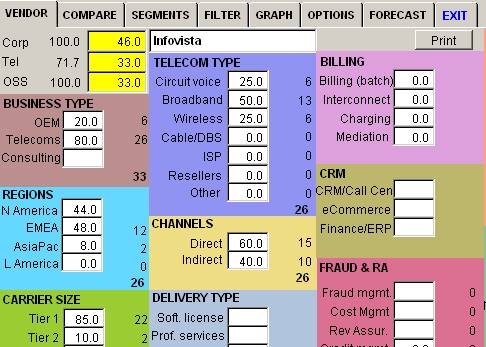
View,
modify, and print our estimates of company financials. . .
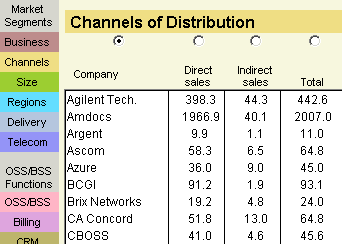
View
market share graphs in international currencies. . .
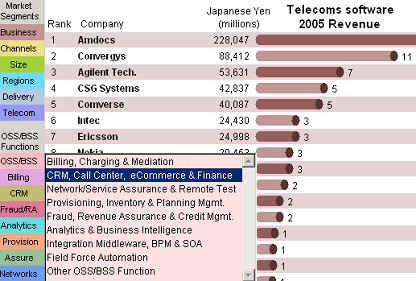
Compare company financials. . .
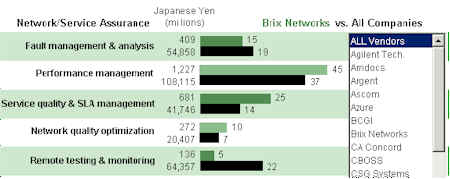
Perform
fast text searches on the desktop. . .
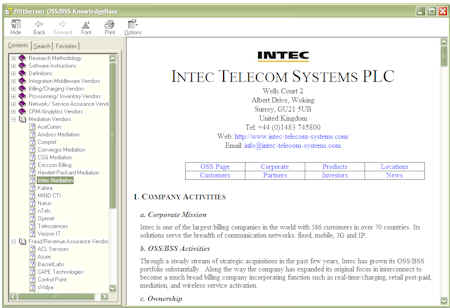
Technology Research Institute
4-25 Rocky Mountain North
Effort of the Poconos, PA 18330
Tel: 570-620-2320
dbaker at technology-research.com
|